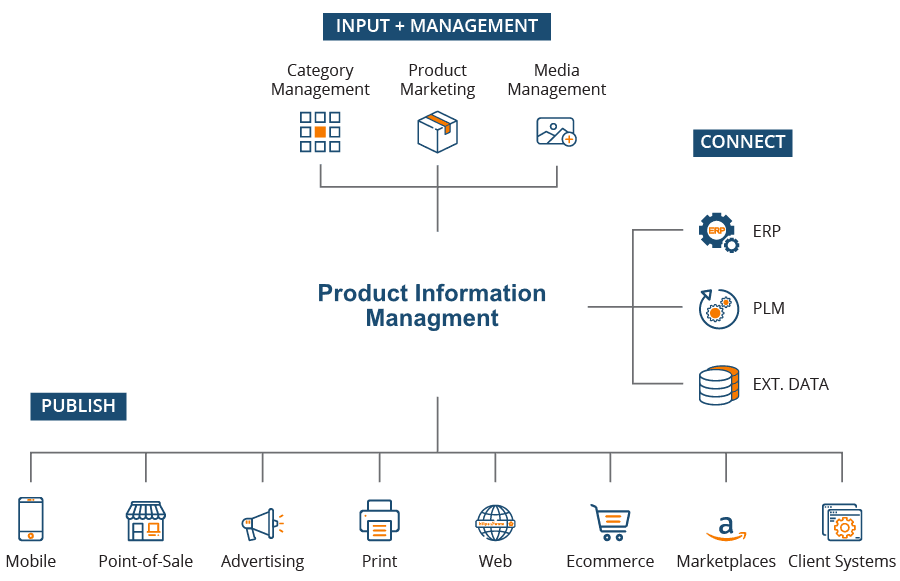- #1 Understand the basics
- #2 Identify & Engage stakeholders
- #3 Understand the flow of Product Information
- #4 Prepare for Data Cleanup
- #5 Consider Data Security & Compliance
- #6 Map Processess
- #7 Assess Integrations
- #8 Create a feature wish-list
- #9 Define the scope
- #10 Define KPIs
- #11 Choose the right vendor and integrator
- #12 Prepare for the training and adaptation period
- Summary

How to prepare for PIM implementation: 12 steps you can't skip
- #1 Understand the basics
- #2 Identify & Engage stakeholders
- #3 Understand the flow of Product Information
- #4 Prepare for Data Cleanup
- #5 Consider Data Security & Compliance
- #6 Map Processess
- #7 Assess Integrations
- #8 Create a feature wish-list
- #9 Define the scope
- #10 Define KPIs
- #11 Choose the right vendor and integrator
- #12 Prepare for the training and adaptation period
- Summary
PIM systems promise to solve countless problems and be a game changer for your business. And they certainly can. Yet, a promise of a bright future can tempt you to jump onto the PIM train immediately - without proper preparation. Such an approach has a chance of giving you quick results, but the results will not be what you expected.
In many cases, PIM Implementation is much more than installing a system and developing customizations. It’s about getting control of your data, it’s about automating processes, but most of all - it’s about changing the way you handle product information.
If you’re considering starting a PIM Implementation - this article is for you.
#1 Understand the basics
Like with everything, you need to understand the basics of PIM to hop onto the PIM Implementation. You can do it in many ways - read case studies, go through feature lists, or engage a system integrator to ask questions.
No matter how you decide to educate yourself - at this stage, you should have a single goal in mind: Find out how a PIM system can help YOU. When it comes to product information management - there is no one-size-fits-all approach. Before you start an implementation, be sure to know what problems you want to solve and what goals you’d like to achieve.
#2 Identify & Engage stakeholders
Embarking on a journey of PIM implementation isn't about the technology - it's also about the people who'll use it. Think of PIM as the heart of your product data universe. Like the heart pumps blood to different body parts, a PIM system pushes product information to various touchpoints.
To make your PIM implementation seamless, begin by identifying all potential stakeholders. Who in your organization will be affected by the PIM? Will it be the product managers who need to input product details? Or perhaps the marketing team, who will use the data to create promotional materials? Maybe the e-commerce division needs to ensure accurate product listings online. Make a comprehensive list.
Once you have your list, the next step is communication. Engage with these departments early and keep the lines open. Inform everyone about the upcoming change, explaining the benefits and how it will affect their daily operations. Encourage questions and feedback. When people feel included and informed from the beginning, they're more likely to be supportive and proactive.
#3 Understand the flow of Product Information

A PIM system's success hinges on the flow of product information. Before diving into implementation, take a step back and map out your data's journey. Where does it originate? How does it move through your organization? Where does it need to land?
If you’re looking at the first PIM in your organization, you might notice that information is all over the place. In a notebook of a procurement guy, on some shared disk created a decade ago, or huge Excel files that take minutes to open. If that’s the case - don’t get discouraged. That’s normal, and that’s exactly why you’re looking into PIM direction.
Although it wouldn’t hurt anything other than your mental health, gathering data in one place before the implementation is unnecessary. However, a clear picture of where data is, and its intended destination sets the stage for a successful PIM implementation. So, ensure that when the time comes - you are 100% certain you can find the data.
#4 Prepare for Data Cleanup
Let’s face it: product data can sometimes resemble a teenager's bedroom. A little chaotic, cluttered, and full of things you're not quite sure you need anymore. And like the rare opportunity when said teenager is away at camp, PIM Implementation presents a golden chance to roll up your sleeves and tidy things up.
While you don't need to ensure every piece of data is spotless pre-implementation, you should have a strategy on what needs a deep clean. Think of it as identifying which 'clothes' still fit, which ones need mending, and which ones are destined for the donation bin.
The beauty of PIM Implementation is that it's not about tidying up - it's about setting a standard. PIM implementation is your moment to redefine how product information should look, feel, and function. These standards, once set, will be your beacon, guiding your product data practices for years to come. So, embrace this rare opportunity. After all, a cleaned-up data 'room' not only looks better but makes day-to-day operations a whole lot smoother!
#5 Consider Data Security & Compliance
Implementing a PIM system is a significant step towards better data management. However, it also comes with the responsibility of ensuring data security and compliance. Not every member of your organization should have access to all data. Some information may be sensitive, proprietary, or restricted for various reasons, and a PIM can help regulate who sees what.
It's essential to be proactive about this. Start by creating a list of regulations that your product data must adhere to. These could range from global standards like DPP to local regulations and even specific industry mandates. Understanding these requirements can help you configure your PIM system to meet these standards effortlessly.
Furthermore, it's not only your data that needs to be compliant. The PIM system itself must align with the legal and regulatory frameworks of your region and organization. By ensuring both your product data and the PIM system are compliant, you'll be laying the foundation for secure, efficient, and legally sound product information management.
#6 Map Processess

One of the game-changing advantages of a PIM system is its ability to streamline workflows. A buzzword - I know. But it really is that important and powerful. However, to truly harness this benefit, a thorough process mapping exercise is indispensable. Just throwing data into the new system won’t solve all your information management problems. But throwing everything into one place and then securing processes with workflows and automation - that’s where the magic happens.
Here are some tips for where to look:
- Product Onboarding: Begin by identifying who in your organization is responsible for introducing a new product into the system. This is often the starting point of the product's digital journey.
- Product Enrichment: Once onboarded, products usually require further detailing or enrichment. Do you know who adds those extra layers of information?
- Translations: If you're operating in a multilingual environment, translations are essential. Are you handling translations in-house or via an agency? Would you like them to be able to enter the system? Or maybe even take a step further and request translations automatically?
- Media Management: Visuals play a key role in product information. Determine who is responsible for uploading images, videos, and other multimedia elements. Also, establish how these are stored, updated, or archived.
- Technical Sheets and Documents: If your products come with technical sheets or other documentation - there is a huge opportunity. Who creates, updates, and ensures these documents align with the actual product specifications? Maybe it’s time to generate them directly from product specifications?
- Release of Information: Once a product's data is onboarded, enriched, and vetted, who gives the green light for it to be published or shared? PIM system can aid the vetting process or even take it over completely.
#7 Assess Integrations
As soon as you’re done with the data - it’s time to start looking into the technology. This isn’t about listing systems - it's about understanding their interplay. Gaining this insight ensures you choose a PIM system that feels less like an addition and more like a natural extension of your infrastructure.
Understanding what systems are involved and how will allow you to take the next step - the integrations roadmap. The goal here is to assess how much time and money you can save on integrating each system. With that knowledge, you can prioritize heavy hitters like ERP or e-commerce and leave the rest for later.
Even if your aim is to integrate everything - you don’t need to do it all at once. It’s way better to start reaping the benefits of the PIM system before you are able to secure a budget for every single integration on your list.
#8 Create a feature wish-list
While it's true that a PIM can address a myriad of challenges, it's essential to recognize that no system is a magic wand that fixes everything. However, this reality check shouldn’t dampen your aspirations. Before you even start choosing the right system - let yourself and your team dream a little.
Encourage your team to get creative. Ask everyone involved to note down their ideal features and functionalities. This isn't an exercise in imagination - it's about capturing the collective needs and desires of those who will use the system day-to-day.
While every wish might not be granted, this list serves a vital role. It provides a comprehensive understanding of your organization's requirements. It will assist system integrators in pinpointing the best PIM for your organization. More than that, it sets the stage for getting the most value out of your PIM system investment.
#9 Define the scope
Once you've assembled your feature wish list, the challenge is determining where to begin. While every wish on the list might seem essential, tackling everything at once can lead to high costs and extended timelines.
Instead, prioritize the most critical features or challenges to address first. This helps to ensure that your initial implementation delivers immediate value. By defining the scope of your initial project, you can manage resources more effectively.
After the foundational implementation, give your team time to adjust and engage with the new system. As they work, they'll gain a clearer understanding of what's needed next. By adopting this step-by-step approach, you allow for a smoother transition. The gradual implementation also ensures that the PIM keeps adapting to evolving needs.
#10 Define KPIs
In the midst of the excitement of integrating a new system, there's a foundational step that's often missed. Setting Key Performance Indicators (KPIs). These are more than just numbers or metrics - they're clear markers of your journey's progress.
Before you even start the PIM implementation, ask yourself: "What do we hope to achieve?" Maybe it's faster product launches, more accurate data, or better team collaboration. Once you identify these goals, you can then define the KPIs that will help you measure them. For instance, if faster product launches are a goal, a relevant KPI might be the average time taken from product conception to market release.
By setting these KPIs early on, you'll not only have a clearer vision of success but also a tangible way to assess the impact of the PIM system. This approach ensures you can celebrate the wins, understand the challenges, and continually refine your processes to get the most out of your new system.
#11 Choose the right vendor and integrator
When choosing a PIM platform, you should consider if you’re aiming for endless customizability or quick implementation. In most cases (but not all of them), the more customizable system is, the longer the implementation takes. On the other hand, having many out-of-the-box features can limit flexibility but significantly reduce the initial cost.
Then comes the equally vital decision - choosing the right agency for the implementation. An ideal integrator is one who understands your goals, advocating for solutions that best serve your interests. A tip? Opt for integrators with experience across various PIM systems. Their broad knowledge base ensures you get unbiased advice. If they're exclusively tied to one system, they might try to convince you it's the best fit, even if it isn't.
Beyond just implementing the system, a seasoned PIM Partner can also guide you in selecting the ideal platform. Their insights, molded by varied experiences with different systems, can be invaluable in matching you with the right PIM
Having troubles finding the right partner?
Implementing a product information management system is too important to make a wrong choice. Check out our other article that will help you spot the red flags of IT companies.
See the red flags of IT partners#12 Prepare for the training and adaptation period
Implementing a PIM system is just the beginning. Ensuring everyone knows how to use it is the next crucial step. Recognize that there's a learning curve. It's essential to allocate time for comprehensive training.
This training shouldn't be a one-size-fits-all approach. Different departments will use the PIM differently. For instance, the Marketing team might focus on product presentation while the Production team delves into technical specifications. Ensure training sessions are targeted so everyone knows how to use the system during their daily operations.
Summary
Implementing a Product Information Management system is not just about adopting new software - it's about transforming how your organization manages product data. Key steps include:
- Understanding the foundational concepts of PIM
- Engaging stakeholders
- Prioritizing features
- Planning for data cleanup
- Selecting a PIM vendor that resonates with your requirements
- Anticipating an adaptation period to refine processes post-launch
With a strategic approach and the right preparations, you can maximize the value of your investment.
Feeling overwhelmed?
Implementation of a new system can seem intimidating. If you need help with preparing for a new implementation - drop us a message. We will explain in detail each step you need to take, to make your implementation a success.
Discuss PIM ImplementationAsk us any question
We will respond within 8 hours and guide you in the right direction.
Your data is safe with us. We will not share your email with anyone, and we will use it only to contact you regarding your inquiry.
